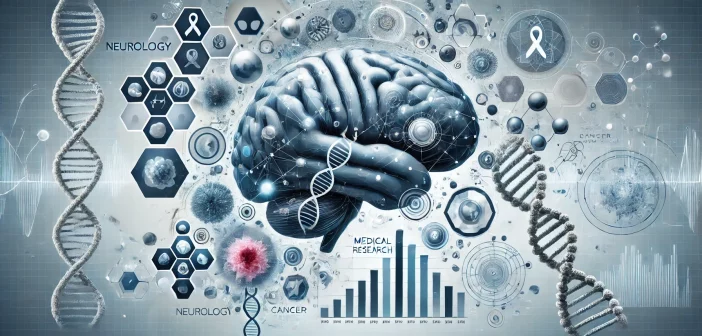The fields of neurology and oncología are advancing rapidly, driven by the need to understand complex diseases that significantly impact patients’ lives. From brain cancers such as Glioblastoma Multiforme (GBM) to neurodegenerative diseases like Parkinson’s and Alzheimer’s, medical researchers are exploring new treatments and drugs. The role of biostatistical analysis in these fields is critical, as it helps to make sense of vast amounts of data and uncover meaningful insights that drive treatment decisions.
Whether analyzing the effects of anti-epileptic drugs (AEDs) on brain tumor patients or studying the efficacy of new treatments for multiple sclerosis (MS) or neuro-oncological conditions, rigorous statistical analysis is essential to improving patient outcomes. In this blog, we’ll explore how expert biostatistical analysis can accelerate breakthroughs in neurology and oncology, focusing on several diseases and treatments that rely on data-driven insights to inform clinical practices. We’ll also highlight how platforms like Kolabtree offer the expertise needed to make sense of complex medical data and drive forward cutting-edge research.
The Growing Complexity of Neurological and Oncological Research
Neurological and oncological conditions are among the most complex and difficult-to-treat diseases. Diseases like GBM, Parkinson’s, Alzheimer’s, multiple sclerosis (MS), and epilepsy involve intricate networks of cellular interactions and genetic mutations, which require nuanced, multi-layered research approaches.
In the world of oncology, cancer treatments are often determined by genetic factors and tumor biology, meaning that targeted therapies, immunotherapies, and chemotherapeutic regimens must be carefully tailored for each patient. Similarly, in neurology, treatment protocols for conditions like Alzheimer’s disease, Parkinson’s disease, and MS are evolving as new drugs and therapies are tested in ensayos clínicos.
Given the vast amounts of data generated in these areas, from patient health records to clinical trials and treatment outcomes, researchers face significant challenges when it comes to interpreting and analyzing the data. To ensure accurate, reliable results, advanced statistical techniques are needed to:
– Adjust for confounding variables.
– Analyze survival outcomes.
– Explore subgroup effects (e.g., age, gender, genetic markers).
– Assess the efficacy of different drugs and treatment protocols.
Why Specialized Expertise Matters in Biostatistical Analysis
Interpreting the data from neurological and oncological research requires more than basic statistical skills—it demands specialized expertise in bioestadística, epidemiologíay ciencia de los datos. Each study or clinical trial may involve different statistical methods, depending on the type of data collected and the specific research questions being asked.
For instance, the impact of drugs such as AEDs on GBM patients’ survival needs survival analysis techniques such as Kaplan-Meier curves or Cox proportional hazards models to understand time-to-event outcomes. But beyond GBM, the same complexity exists for other diseases, each requiring tailored analytical approaches.
Parkinson’s Disease and Deep Brain Stimulation (DBS): Parkinson’s disease is a degenerative neurological condition that often leads to severe motor impairment. One of the most promising treatments is DBS, a surgical intervention that alleviates motor symptoms. Analyzing the long-term effectiveness of DBS requires survival analysis, as well as regression models to adjust for patient characteristics such as age and disease severity.
Alzheimer’s Disease and Anti-Amyloid Therapies: Alzheimer’s is another area where advanced statistical methods are essential. As new therapies, such as monoclonal antibodies targeting amyloid-beta plaques, are developed, researchers must analyze data from clinical trials to determine their efficacy. This involves not only comparing treatment and placebo groups but also conducting subgroup analysis to assess which patients respond best to the treatment based on genetic factors or disease stage.
Multiple Sclerosis and Disease-Modifying Therapies (DMTs): For patients with MS, disease-modifying therapies (DMTs) are used to slow disease progression and reduce relapse rates. Biostatistical analysis plays a key role in determining the long-term effectiveness of DMTs, requiring longitudinal análisis de datos and mixed-effects models to account for the variability in disease progression over time.
Lung Cancer and Immunotherapy: Immunotherapies such as checkpoint inhibitors have transformed the treatment landscape for several types of cancer, including lung cancer. However, understanding which patients are most likely to benefit from these therapies requires a robust statistical approach, including adjusted survival analyses and multivariable models to account for differences in tumor genética, immune markers, and previous treatments.
Case Example: How Biostatistical Analysis Drives Insights in Neurology and Oncology
Let’s consider a real-world example of how biostatistical analysis can be applied across multiple diseases. Suppose a researcher is analyzing data from patients with GBM, epilepsy, and MS to assess the impact of different drug treatments on survival and quality of life. The dataset contains information on 500 patients, including their treatment regimens, clinical outcomes, and demographic characteristics.
The researcher could pose several key questions:
1. Impact of AEDs on Epileptic Patients with Brain Tumors: A biostatistical expert might use Cox proportional hazards models to analyze the survival of patients with GBM who are also treated with AEDs for seizure management. The analysis could adjust for confounding factors such as tumor size, extent of resection (EoR), and patient age.
2. Impact of Disease-Modifying Therapies in MS: The researcher could apply longitudinal data analysis techniques to assess the progression of MS in patients receiving DMTs. Mixed-effects models might be used to account for repeated measurements over time, providing insights into how DMTs influence the rate of disability progression in different patient subgroups.
3. Parkinson’s Disease and the Long-Term Effectiveness of DBS: To evaluate the long-term benefits of DBS in Parkinson’s patients, the researcher could use Kaplan-Meier curves to estimate survival rates and assess motor function improvement over time. Subgroup analysis could reveal whether specific patient characteristics (e.g., age, disease stage) are associated with better outcomes.
In each of these cases, the biostatistical expert would provide insights that go beyond surface-level data analysis, helping the researcher to answer complex questions and make informed decisions about the next steps in their research.
Why Kolabtree is the Ideal Platform for Biostatistical Expertise
Given the complexity of the diseases and treatments mentioned, salud researchers often require specialized skills that go beyond basic statistical analysis. This is where Kolabtree comes in, providing access to a global pool of expert biostatisticians, epidemiologists, and data scientists who are equipped to handle complex medical datasets.
Kolabtree enables healthcare organizations and researchers to:
– Access freelance experts with experience in neurology, oncology, and biostatistics.
– Get tailored support for analyzing survival data, conducting regression analyses, and performing complex statistical tests.
– Collaborate with experts who can help refine research questions and ensure that the data is interpreted accurately.
Whether you are conducting clinical trials on Alzheimer’s treatments or analyzing the long-term effectiveness of immunotherapies in lung cancer patients, Kolabtree offers the expertise you need to make sense of your data and draw meaningful conclusions that can drive medical breakthroughs.
Conclusion: The Future of Data-Driven Medical Research
In today’s data-driven world, medical research in neurology and oncology hinges on the ability to accurately analyze and interpret complex datasets. From AEDs in GBM patients to DBS in Parkinson’s and DMTs in MS, biostatistical expertise is essential for unlocking new insights that improve patient outcomes.
Kolabtree offers a unique opportunity for healthcare researchers to access the specialized expertise they need to tackle complex biostatistical challenges. By connecting with the right experts, researchers can ensure that their findings are accurate, actionable, and ultimately beneficial to the medical community.
Ready to accelerate your research with expert biostatistical analysis? Kolabtree's global network of freelance experts is here to help. Start your next project today and take your research to the next level.







